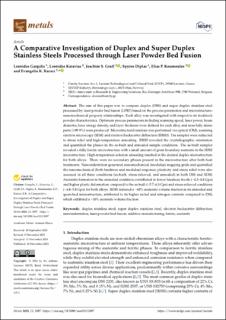| dc.contributor.author | Gargalis, Leonidas | |
| dc.contributor.author | Karavias, Leonidas | |
| dc.contributor.author | Graff, Joachim Seland | |
| dc.contributor.author | Diplas, Spyridon | |
| dc.contributor.author | Koumoulos, Elias P. | |
| dc.contributor.author | Karaxi, Evangelia K. | |
| dc.date.accessioned | 2024-04-12T11:13:05Z | |
| dc.date.available | 2024-04-12T11:13:05Z | |
| dc.date.created | 2023-12-08T10:55:33Z | |
| dc.date.issued | 2023 | |
| dc.identifier.citation | Metals. 2023, 13(11): 1897. | en_US |
| dc.identifier.issn | 2075-4701 | |
| dc.identifier.uri | https://hdl.handle.net/11250/3126280 | |
| dc.description.abstract | The aim of this paper was to compare duplex (DSS) and super duplex stainless steel processed by laser powder bed fusion (LPBF) based on the process parameters and microstructure–nanomechanical property relationships. Each alloy was investigated with respect to its feedstock powder characteristics. Optimum process parameters including scanning speed, laser power, beam diameter, laser energy density, and layer thickness were defined for each alloy, and near-fully dense parts (>99.9%) were produced. Microstructural analysis was performed via optical (OM), scanning electron microscopy (SEM) and electron backscatter diffraction (EBSD). The samples were subjected to stress relief and high-temperature annealing. EBSD revealed the crystallographic orientation and quantified the phases in the as-built and annealed sample conditions. The as-built samples revealed a fully ferritic microstructure with a small amount of grain boundary austenite in the SDSS microstructure. High-temperature solution annealing resulted in the desired duplex microstructure for both alloys. There were no secondary phases present in the microstructure after both heat treatments. Nanoindentation generated nanomechanical (modulus) mapping grids and quantified the nanomechanical (both hardness and modulus) response; plasticity and stress relief were also assessed in all three conditions (as-built, stress-relieved, and annealed) in both DSS and SDSS. Austenite formation in the annealed condition contributed to lower hardness levels (~4.3–4.8 Gpa) and higher plastic deformation compared to the as-built (~5.7–6.3 Gpa) and stress-relieved conditions (~4.8–5.8 Gpa) for both alloys. SDSS featured a ~60% austenite volume fraction in its annealed and quenched microstructure, attributed to its higher nickel and nitrogen contents compared to DSS, which exhibited a ~30% austenite volume fraction. | en_US |
| dc.language.iso | eng | en_US |
| dc.publisher | MDPI | en_US |
| dc.rights | Navngivelse 4.0 Internasjonal | * |
| dc.rights.uri | http://creativecommons.org/licenses/by/4.0/deed.no | * |
| dc.title | A Comparative Investigation of Duplex and Super Duplex Stainless Steels Processed through Laser Powder Bed Fusion | en_US |
| dc.title.alternative | A Comparative Investigation of Duplex and Super Duplex Stainless Steels Processed through Laser Powder Bed Fusion | en_US |
| dc.type | Peer reviewed | en_US |
| dc.type | Journal article | en_US |
| dc.description.version | publishedVersion | en_US |
| dc.rights.holder | © 2023 by the authors. Published by MDPI. | en_US |
| dc.source.pagenumber | 30 | en_US |
| dc.source.volume | 13 | en_US |
| dc.source.journal | Metals | en_US |
| dc.source.issue | 11 | en_US |
| dc.identifier.doi | 10.3390/met13111897 | |
| dc.identifier.cristin | 2210901 | |
| dc.relation.project | EC/H2020/952869 | en_US |
| dc.source.articlenumber | 1897 | en_US |
| cristin.ispublished | true | |
| cristin.fulltext | original | |
| cristin.qualitycode | 1 | |

